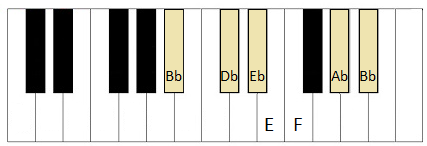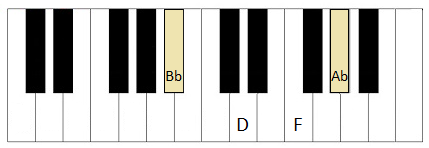Playing the blues scale on piano can seem very different compared with the standard scales you learn when say practicing for your classical grades. The notes just don’t seem to make sense, and to seem people seem awkward and difficult to play.
However, the blues scale is not as hard as it seems and by learning these notes you will then be able to build up your knowledge of what works when playing the blues and how you can use them to improvise.
Before we get to the blues scale in the key of B flat, let’s first of all look at a standard blues scale in C…

Here’s what this sounds like –
For a full understanding of why these notes work and how they create a blues sound, please go to – The blues scale for piano – all you need to know.
Let’s now take a look at the same blues scale but in the key of B flat:

Here’s how it sounds –
What fingers should I use to play the B flat blues scale?
When playing a scale like this you will often find that it’s quite hard to figure out which fingers to use. When playing a standard C major scale for instance, you would use the usual 1, 2, 3, 1, 2, 3, 4, 5. The fingers for this blues scale are not too dissimilar, and my recommendation would be this – 1, 2, 3, 1, 2, 3, 4 (or 2, 3, 4, 1, 2, 3, 4).
Practice playing up and down for one octave as seen in the above image, exactly like you would a regular scale. You’d be surprised how quickly you can grasp this unique type of scale, and it won’t take too long for this to feel natural.
How to use the blues scale to create a blues melody
The great thing about the blues scale is that you can instantly use it to create your own blues improvisation song. It doesn’t matter if you’re a complete beginner, as all you need to do is play any of the notes in any order you like until you find something that you’re happy with.
What left hand can I use to play underneath my right hand melody or blues scale?
A fantastic way to start playing with both hands is to play a seventh blues chord underneath the melody with your left hand. Here is what you could use:

This is called a B flat 7th chord and should be played with the fingers – 5, 3, 2, 1 (from left to right). Play this with your left hand at the same time as you play the blues scale with your right. Hold down this chord for a fuller sound to properly accompany your awesome blues right hand scale.
Now that you are more comfortable with the blues scale in B flat, you can now begin to experiment with your own melodies. A great way to do this is to build up your melody one note at a time rather than jumping in feet first with four or five notes.
This type of approach is always the best way to learn how to improvise, as you are keeping things as simple as possible preventing any frustration and hindrance to your learning curve.
For more information on improvisation please read the following article – How do you improvise on the piano?
If you would like to learn how to improvise as well as play lots of famous blues, boogie and rock ‘n’ roll songs like Great Balls of Fire and Blueberry Hill, don’t forget you can subscribe to my blues video course today for only £19.99 (6 months access).
This amazing video course accommodates all abilities from beginners to advanced, and teaches the basics of 12 bar blues including left hand boogie rhythms and amazing right hand melodies.
Learn to play piano blues online with me
My online blues course teaches blues piano from scratch and builds your ability in a modular way. As you progress through the course, you’ll learn left hands, right hands, bridges and endings which you’ll use together to make your own blues piano compositions. I’ll show you the blues scale early on, giving you everything you need to start improvising – and we’ll progress to advanced licks and an impressive tutorial song to consolidate your new skills. Finally, we’ll move onto some popular blues songs, including music by the great Jerry Lee Lewis and my own personal favourite, Ray Charles.
I charge just £19.99 for 6 full months access, with 58 videos and counting – that’s less than the cost of a single piano lesson! – and I offer a 100% satisfaction money back guarantee.

Leave a Reply